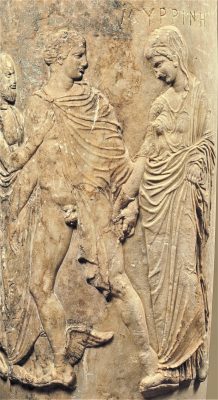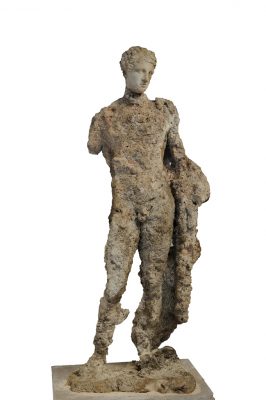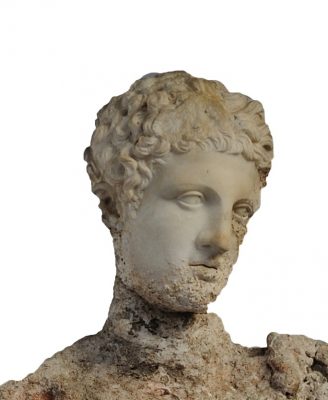How did a shepherd evolve into the messenger of the gods? How did a bearded, ithyphallic demon of the peasants and the mysteries evolve into the handsome young god in the Iliad?
Born on Mount Kyllene in Arcadia, the child of Zeus by the nymph Maia, began his life behaving bad: only four days old he stole the herd of oxen kept by his half-brother Apollo. Their father ordered the baby thief to return the herd and the two brothers exchanged courtesy gifts.
Apollo gave his younger brother the kerykeion, the staff of prosperity and wealth, a symbol of Hermes as a protector of profit, trade and gambling. The male and female intertwined serpents forming the staff refer to the original demonic and fertility nature of the god. He holds the staff as an earthly “good shepherd”, as a king “shepherd of people” and as an overseer of rituals and sacrifices. In turn, he gave Apollo his symbol, the lyre, making it himself from a turtle shell. His relationship with music extended later to the making of the wind instrument syrinx (pipes), the symbol of his son, Pan.
His name (hermax = cairn) refers to the burial stone piles that functioned as markers in the countryside. Shepherds and farmers often moved them to appropriate land from the adjacent properties, until the authorities introduced, in the 6th century BC, as landmarks the fixed square columns with a rudimentary rendering of the god, only his head and genitals, the Hermaic stele or “square Hermes”. So the god became the protector of boundaries, of gates, of roads and of travelers and wears their wide-brimmed hat.

The Hermaic stele genitals were touched by men taking an oath “to their virility” (testes = testicles / testify). Thus the god became also the protector of the courts and the oath.
Being a god of transitions, he oversaw the education of boys between their childhood and adulthood, in the gymnasia. Between gods and men, he flied in the ether as an “angel / messenger” of divine messages, wearing winged hat and sandals. Leading the way between the living and the dead he guided the souls to the Underworld, but he did not inflict death.

In the Hellenistic and Roman periods, amid metaphysical quests, Hermes / Mercurius incorporated aspects of the Egyptian god Thoth or Hermes the Great, protector of language and letters, astronomy, medicine, and the arts.
In order to impart the image of this “great cosmic ruler” to the Hermes statue, a copy of a bronze original of 360-350 BC, white Parian marble was used by a Peloponnesian sculptor, conforming to the rules of the Polykleteian sculpture tradition.


In his lost book The Canon, the 5th century BC Peloponnesian sculptor Polykleitos set down the rules for the ideal proportions of the human body in sculpture. We conclude the book’s content from the Roman copies of his works. The most important one is the Doryphoros or Canon, a statue of a nude young man holding a spear. Like Hermes from the Antikythera shipwreck, he steps with one foot firmly, bending and extending the other leg; thus the pelvis necessarily leans to the opposite direction of the shoulders. These contrasting movements result in a body appearing at the same time moving and balanced.
The Aegean Sea eroded the body of the large sculpture, when the boat carrying it along with many other works of art sunk during a storm in the 1st century BC, near the Antikythera Island. Yet, the beautiful face with small eyes, long nose, half-open lips, and crowned by the short hair-locks, remained protected in the sand. A wonderful head of the young god, the “most Greek of all the Olympian gods”.
This was originally posted in support of our exhibition Ancient Greeks: Science and Wisdom that was open from 17 November 2021 – 5 June 2022. This collection displayed intriguing examples of how science is being used to uncover new insights about the Ancient Greek world.
